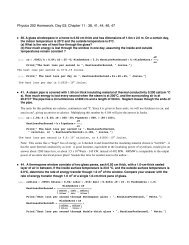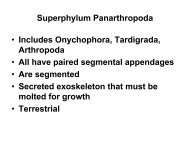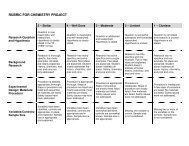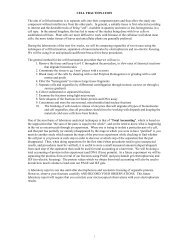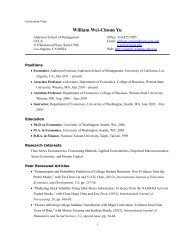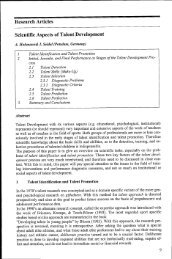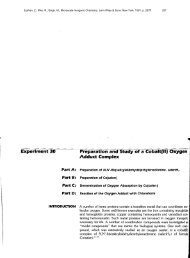The Effect of Defendant's Courtroom Attire on Jurors' Verdicts
The Effect of Defendant's Courtroom Attire on Jurors' Verdicts
The Effect of Defendant's Courtroom Attire on Jurors' Verdicts
You also want an ePaper? Increase the reach of your titles
YUMPU automatically turns print PDFs into web optimized ePapers that Google loves.
<str<strong>on</strong>g>Effect</str<strong>on</strong>g> <str<strong>on</strong>g>of</str<strong>on</strong>g> Defendant’s <str<strong>on</strong>g>Courtroom</str<strong>on</strong>g> <str<strong>on</strong>g>Attire</str<strong>on</strong>g> 1<br />
<str<strong>on</strong>g>The</str<strong>on</strong>g> <str<strong>on</strong>g>Effect</str<strong>on</strong>g> <str<strong>on</strong>g>of</str<strong>on</strong>g> Defendant’s <str<strong>on</strong>g>Courtroom</str<strong>on</strong>g> <str<strong>on</strong>g>Attire</str<strong>on</strong>g> <strong>on</strong> Jurors’ <strong>Verdicts</strong><br />
Kateri Schafer<br />
Win<strong>on</strong>a State University<br />
Abstract<br />
Studies <strong>on</strong> a pers<strong>on</strong>’s physical appearance in associati<strong>on</strong> with social likability have shown that people<br />
typically react more favorably to people rated as more physically attractive. Studies also show that the<br />
same holds true in criminal court trials and that more attractive defendants are seen as less guilty and<br />
typically receive more lenient punishments. However, little research exists <strong>on</strong> the effects <str<strong>on</strong>g>of</str<strong>on</strong>g> a defendant’s<br />
courtroom attire <strong>on</strong> verdicts. <str<strong>on</strong>g>The</str<strong>on</strong>g> present study examines whether a defendant depicted in a pris<strong>on</strong><br />
jumpsuit is seen as guiltier than a defendant in dress attire. <str<strong>on</strong>g>The</str<strong>on</strong>g> study also tested juror instructi<strong>on</strong>s, or<br />
priming effects. Although the results were not significant, small findings were present that may open the<br />
door for further research.<br />
<str<strong>on</strong>g>The</str<strong>on</strong>g> <str<strong>on</strong>g>Effect</str<strong>on</strong>g> <str<strong>on</strong>g>of</str<strong>on</strong>g> a Defendant’s <str<strong>on</strong>g>Courtroom</str<strong>on</strong>g> <str<strong>on</strong>g>Attire</str<strong>on</strong>g> <strong>on</strong> Jurors’ <strong>Verdicts</strong><br />
In recent decades, physical appearance has been a widely researched topic in psychology,<br />
especially in criminal court proceedings. While many studies <strong>on</strong> defendant appearance have<br />
found that appearance can influence verdicts, very few, if any, studies exist <strong>on</strong> the levels <str<strong>on</strong>g>of</str<strong>on</strong>g> guilt<br />
or physical attractiveness based <strong>on</strong> the defendant’s courtroom attire. <str<strong>on</strong>g>The</str<strong>on</strong>g> present proposed study<br />
is based <strong>on</strong> a court case regarding the issue <str<strong>on</strong>g>of</str<strong>on</strong>g> the defendant wearing the pris<strong>on</strong> jumpsuit.<br />
In Estelle v. Williams (1976), Williams was c<strong>on</strong>victed <str<strong>on</strong>g>of</str<strong>on</strong>g> attempted murder. He appealed<br />
<strong>on</strong> the basis that he was required to wear pris<strong>on</strong> garb during the trial which violated his<br />
c<strong>on</strong>stituti<strong>on</strong>al right to a fair trial by potentially causing jurors to have prec<strong>on</strong>ceived noti<strong>on</strong>s <str<strong>on</strong>g>of</str<strong>on</strong>g><br />
guilt. <str<strong>on</strong>g>The</str<strong>on</strong>g> Supreme Court ruled that it is unc<strong>on</strong>stituti<strong>on</strong>al to compel the defendant to wear pris<strong>on</strong>
<str<strong>on</strong>g>Effect</str<strong>on</strong>g> <str<strong>on</strong>g>of</str<strong>on</strong>g> Defendant’s <str<strong>on</strong>g>Courtroom</str<strong>on</strong>g> <str<strong>on</strong>g>Attire</str<strong>on</strong>g> 2<br />
attire in fr<strong>on</strong>t <str<strong>on</strong>g>of</str<strong>on</strong>g> a jury; however, the Supreme Court also noted that some defendants chose to<br />
wear the attire in an attempt to elicit sympathy from the jury. It is not uncomm<strong>on</strong> to hear about a<br />
trial in which the defendant moti<strong>on</strong>s for a change in venue due to pretrial publicity and the<br />
pictures in the media that depict him or her in pris<strong>on</strong> attire.<br />
While little has been studied <strong>on</strong> the effect <str<strong>on</strong>g>of</str<strong>on</strong>g> a defendant’s attire, much has been studied<br />
<strong>on</strong> pretrial publicity (PTP). A great deal <str<strong>on</strong>g>of</str<strong>on</strong>g> this research has focused <strong>on</strong> print media such as<br />
newspapers, but because today the majority <str<strong>on</strong>g>of</str<strong>on</strong>g> homes have at least <strong>on</strong>e televisi<strong>on</strong>, the focus has<br />
shifted to televisi<strong>on</strong> media and what kind <str<strong>on</strong>g>of</str<strong>on</strong>g> impact images <str<strong>on</strong>g>of</str<strong>on</strong>g> defendants has <strong>on</strong> individuals.<br />
Studies have found that exposure to this media can cause prejudices. How the media portrays<br />
the defendant can influence how culpable society sees the alleged criminal. Research has shown<br />
that <strong>on</strong>e <str<strong>on</strong>g>of</str<strong>on</strong>g> the factors that c<strong>on</strong>tribute to prejudicial effects is the struggle to block out an image<br />
or thought (Fein et al., 1997). An image <str<strong>on</strong>g>of</str<strong>on</strong>g> a pers<strong>on</strong> in an orange pris<strong>on</strong> jumpsuit may elicit<br />
c<strong>on</strong>tenti<strong>on</strong>s that he or she is in fact guilty because they are already depicted as a pris<strong>on</strong>er. This<br />
research <strong>on</strong> prec<strong>on</strong>ceived noti<strong>on</strong>s due to pretrial publicity leads to the present study. Although<br />
no direct studies <strong>on</strong> how attire affects verdicts have been c<strong>on</strong>ducted, some research does hint at a<br />
possible answer. This research includes effects <str<strong>on</strong>g>of</str<strong>on</strong>g> pers<strong>on</strong>al appearance <strong>on</strong> judgments in general,<br />
and criminal judgments in particular. Also, studies <strong>on</strong> juror instructi<strong>on</strong> may provide some<br />
insight as to whether defendants may be judged <strong>on</strong> attire.<br />
One questi<strong>on</strong> that numerous researchers have set out to answer is do people react more<br />
favorably towards physically attractive people? A very early study hypothesized the stereotype<br />
<str<strong>on</strong>g>of</str<strong>on</strong>g> “what is beautiful is good.” This studied showed that people did in fact rate attractive<br />
individuals as having more prestigious occupati<strong>on</strong>s, being better parents, leading more fulfilling<br />
lives, and overall, being more socially desirable. <str<strong>on</strong>g>The</str<strong>on</strong>g> participants even rated a pretty woman to<br />
be less likely to commit a crime (Di<strong>on</strong>, Berscheid, and Walster, 1972). In accordance with the<br />
“what is beautiful is good” stereotype, much research has been d<strong>on</strong>e <strong>on</strong> criminal defendants’<br />
attractiveness in correlati<strong>on</strong> with a guilty verdict in court trials. Efran (1974), hypothesized that<br />
physically attractive defendants would be less likely to be found guilty and would receive more<br />
lenient punishment by mock jurors. In his opini<strong>on</strong> survey, participants agreed with the statement<br />
that a defendant should not be judged <strong>on</strong> any aspect <str<strong>on</strong>g>of</str<strong>on</strong>g> his appearance. However, when he<br />
c<strong>on</strong>ducted an experiment to answer this questi<strong>on</strong>, he found people said <strong>on</strong>e thing, and did
<str<strong>on</strong>g>Effect</str<strong>on</strong>g> <str<strong>on</strong>g>of</str<strong>on</strong>g> Defendant’s <str<strong>on</strong>g>Courtroom</str<strong>on</strong>g> <str<strong>on</strong>g>Attire</str<strong>on</strong>g> 3<br />
another. <str<strong>on</strong>g>The</str<strong>on</strong>g> results were c<strong>on</strong>sistent with his initial hypothesis: defendants who were more<br />
physically attractive were assessed with a less certainty <str<strong>on</strong>g>of</str<strong>on</strong>g> guilt and more lenient punishments<br />
were given.<br />
A more recent study was c<strong>on</strong>ducted to determine both the physical attractiveness and<br />
level <str<strong>on</strong>g>of</str<strong>on</strong>g> guilt <str<strong>on</strong>g>of</str<strong>on</strong>g> both male and female defendants who were smiling versus not smiling. <str<strong>on</strong>g>The</str<strong>on</strong>g><br />
researchers found that participants rated smiling defendants, both male and female, as more<br />
physically attractive, but they did not find any significant results <strong>on</strong> level <str<strong>on</strong>g>of</str<strong>on</strong>g> guilt based <strong>on</strong><br />
smiling for either sex (Abel and Watters, 2005). <str<strong>on</strong>g>The</str<strong>on</strong>g>se results show that simple facial<br />
expressi<strong>on</strong>s may influence how a pers<strong>on</strong> sees another.<br />
While these studies are evidence that mock jurors do take physical appearance into<br />
c<strong>on</strong>siderati<strong>on</strong> when making a decisi<strong>on</strong>, can these results be generalized to actual court trials?<br />
One field study shows that this still holds true in actual judicial cases. Judges were asked to rate<br />
previous defendants <strong>on</strong> the attractiveness. Those ratings were than correlated with the verdict <str<strong>on</strong>g>of</str<strong>on</strong>g><br />
their case and the severity <str<strong>on</strong>g>of</str<strong>on</strong>g> their punishment. A positive relati<strong>on</strong>ship was found between<br />
attractiveness and the sentencing with more attractive defendants receiving less guilty verdicts<br />
and more lenient sentences (Stewart, 1980). In another study, it was found that juror members<br />
not <strong>on</strong>ly see unattractive defendants as guiltier, but also describe them as “typical” criminals who<br />
will be more likely to relapse (H<str<strong>on</strong>g>of</str<strong>on</strong>g>fman, 1981). <str<strong>on</strong>g>The</str<strong>on</strong>g>se field studies indicate that even outside<br />
c<strong>on</strong>trolled, laboratory experiments, biases towards attractive people still are present in judicial<br />
proceedings. This evidence can be a major c<strong>on</strong>cern in court cases when an individual’s sentence<br />
lies in the hands <str<strong>on</strong>g>of</str<strong>on</strong>g> a jury.<br />
Another issue in court trials has been the effectiveness <str<strong>on</strong>g>of</str<strong>on</strong>g> juror instructi<strong>on</strong>s. Results have<br />
shown that for the most part, comprehensi<strong>on</strong> <str<strong>on</strong>g>of</str<strong>on</strong>g> the instructi<strong>on</strong>s is rather poor. Legal terms are<br />
<str<strong>on</strong>g>of</str<strong>on</strong>g>ten bey<strong>on</strong>d the knowledge <str<strong>on</strong>g>of</str<strong>on</strong>g> a laypers<strong>on</strong>, laws or evidence can be misunderstood, or jurors<br />
may decide to ignore some aspects <str<strong>on</strong>g>of</str<strong>on</strong>g> the instructi<strong>on</strong>s and put more emphasis <strong>on</strong> others based <strong>on</strong><br />
their own values and beliefs (Leiberman and Sales, 1997). One problem that can occur in juror<br />
instructi<strong>on</strong>s is the boomerang effect. This is when a judge instructs the jurors to disregard a<br />
statement, piece <str<strong>on</strong>g>of</str<strong>on</strong>g> evidence, or to avoid factoring some other aspect into their decisi<strong>on</strong>, but by<br />
doing so, the juror’s attenti<strong>on</strong> is actually drawn more to that feature <str<strong>on</strong>g>of</str<strong>on</strong>g> the case (Fleming,<br />
Wegener, & Petty, 1998). <str<strong>on</strong>g>The</str<strong>on</strong>g> present study will examine a priming effect, which is similar to
<str<strong>on</strong>g>Effect</str<strong>on</strong>g> <str<strong>on</strong>g>of</str<strong>on</strong>g> Defendant’s <str<strong>on</strong>g>Courtroom</str<strong>on</strong>g> <str<strong>on</strong>g>Attire</str<strong>on</strong>g> 4<br />
juror instructi<strong>on</strong>s. <str<strong>on</strong>g>The</str<strong>on</strong>g> jurors will be primed to previous research <strong>on</strong> physical appearance in<br />
court and how appearance can impact jurors’ decisi<strong>on</strong>s. <str<strong>on</strong>g>The</str<strong>on</strong>g>y will then be instructed to avoid<br />
taking physical attributes into c<strong>on</strong>siderati<strong>on</strong> during their deliberati<strong>on</strong>.<br />
<str<strong>on</strong>g>The</str<strong>on</strong>g> questi<strong>on</strong> remains – does the pris<strong>on</strong> jumpsuit have a negative impact <strong>on</strong> jurors and if<br />
so, would a judge’s warning help? Given these previous studies <strong>on</strong> appearance and juror<br />
instructi<strong>on</strong>s, or priming, the following study hypothesizes that a defendant dressed in the pris<strong>on</strong><br />
jumpsuit is more likely to be deemed guilty by mock jurors than a defendant wearing dress<br />
clothing. <str<strong>on</strong>g>The</str<strong>on</strong>g> predicti<strong>on</strong> for the priming is that those who are primed to previous research will<br />
find the defendant less guilty in both the jumpsuit and dress clothing because they will<br />
deliberately try to avoid taking physical attributes into c<strong>on</strong>siderati<strong>on</strong>.<br />
Participants<br />
Methods<br />
Participants were 82 undergraduate students at Win<strong>on</strong>a State University, both male and<br />
female, enrolled in psychology classes in Spring semester 2009. <str<strong>on</strong>g>The</str<strong>on</strong>g>y received a minimal<br />
amount <str<strong>on</strong>g>of</str<strong>on</strong>g> extra credit points for the psychology class.<br />
Materials<br />
An audio recording was used to present the case to the jurors. A male narrator presented<br />
the facts <str<strong>on</strong>g>of</str<strong>on</strong>g> an aggravated robbery case and the arguments by both the prosecuti<strong>on</strong> and defense.<br />
<str<strong>on</strong>g>The</str<strong>on</strong>g> recording described a ficti<strong>on</strong>al gas stati<strong>on</strong> armed robbery in which the clerk was injured.<br />
<str<strong>on</strong>g>The</str<strong>on</strong>g> suspect was picked up near the gas stati<strong>on</strong>. Not <strong>on</strong>ly did the suspect’s car match the<br />
descripti<strong>on</strong> an eyewitness gave, but the clothes he was wearing also matched, and a handgun was<br />
found <strong>on</strong> the fr<strong>on</strong>t seat <str<strong>on</strong>g>of</str<strong>on</strong>g> the car. <str<strong>on</strong>g>The</str<strong>on</strong>g> m<strong>on</strong>ey was not in his car, he had a friend corroborating<br />
his alibi, and there was no DNA found <strong>on</strong> the weap<strong>on</strong> that was used to strike the clerk across the<br />
head. <str<strong>on</strong>g>The</str<strong>on</strong>g> same recording was used in all the c<strong>on</strong>diti<strong>on</strong>s. At the same time, a slide show was<br />
presented through PowerPoint via an LCD projector. <str<strong>on</strong>g>The</str<strong>on</strong>g> slide show c<strong>on</strong>sisted <str<strong>on</strong>g>of</str<strong>on</strong>g> pictures <str<strong>on</strong>g>of</str<strong>on</strong>g><br />
evidence from the case, including the handgun found, the car, and the clothing the suspect was<br />
wearing. Pictures <str<strong>on</strong>g>of</str<strong>on</strong>g> the trial setting included a judge, a bailiff, the prosecuting attorney, and the<br />
defendant wearing a pris<strong>on</strong> jumpsuit for some c<strong>on</strong>diti<strong>on</strong>s, and dress clothing in others. <str<strong>on</strong>g>The</str<strong>on</strong>g> attire
<str<strong>on</strong>g>Effect</str<strong>on</strong>g> <str<strong>on</strong>g>of</str<strong>on</strong>g> Defendant’s <str<strong>on</strong>g>Courtroom</str<strong>on</strong>g> <str<strong>on</strong>g>Attire</str<strong>on</strong>g> 5<br />
was the key independent variable in this study. <str<strong>on</strong>g>The</str<strong>on</strong>g> jumpsuit c<strong>on</strong>diti<strong>on</strong>s saw the defendant in an<br />
orange pris<strong>on</strong> jumpsuit, and the dress clothing c<strong>on</strong>diti<strong>on</strong>s saw the defendant in a dress shirt. <str<strong>on</strong>g>The</str<strong>on</strong>g><br />
angle <str<strong>on</strong>g>of</str<strong>on</strong>g> the pictures and what the defendant was doing were the same in both c<strong>on</strong>diti<strong>on</strong>s; the<br />
<strong>on</strong>ly difference was the apparel. <str<strong>on</strong>g>The</str<strong>on</strong>g> defendant was the same in all c<strong>on</strong>diti<strong>on</strong>s. <str<strong>on</strong>g>The</str<strong>on</strong>g> pictures<br />
were arranged to match the commentary in order to simulate being a juror.<br />
To measure the dependant variables, a questi<strong>on</strong>naire c<strong>on</strong>sisting <str<strong>on</strong>g>of</str<strong>on</strong>g> four questi<strong>on</strong>s was<br />
used. In studies with mock jurors, researchers have used a few different methods <str<strong>on</strong>g>of</str<strong>on</strong>g> obtaining<br />
participants verdicts for the dependent variable. <str<strong>on</strong>g>The</str<strong>on</strong>g> two most popular methods are dichotomous<br />
guilty-or-not-guilty verdicts, or rating scales, typically ranging from 1 to 9. <str<strong>on</strong>g>The</str<strong>on</strong>g> rating scale is<br />
most <str<strong>on</strong>g>of</str<strong>on</strong>g>ten used because it can measure exactly how guilty or not guilty a resp<strong>on</strong>dent believes the<br />
defendant to be. It is also easier to analyze because statistical processes such as ANOVA or t-<br />
tests can be carried out (Leiberman and Sales, 1997). <str<strong>on</strong>g>The</str<strong>on</strong>g> present study uses both the<br />
dichotomous guilty-or-not-guilty verdict and scale <str<strong>on</strong>g>of</str<strong>on</strong>g> certainty. If an effect is present from the<br />
dichotomous verdict, the scale will help measure the degree <str<strong>on</strong>g>of</str<strong>on</strong>g> c<strong>on</strong>fidence in their verdict<br />
<str<strong>on</strong>g>The</str<strong>on</strong>g> first questi<strong>on</strong> <str<strong>on</strong>g>of</str<strong>on</strong>g> the questi<strong>on</strong>naire asked what verdict the resp<strong>on</strong>dent would render<br />
and asked him/her to circle guilty or not guilty. <str<strong>on</strong>g>The</str<strong>on</strong>g> sec<strong>on</strong>d questi<strong>on</strong> asked how certain the<br />
participant was and had a scale from 1 to 10, 1 being definitely not guilty, 10 being definitely<br />
guilty. <str<strong>on</strong>g>The</str<strong>on</strong>g> third questi<strong>on</strong> asked what sentence the resp<strong>on</strong>dent felt the defendant should receive<br />
if he were found guilty. <str<strong>on</strong>g>The</str<strong>on</strong>g> scale ranged from 1 to 6, 1 being less than 1 year, 6 being more<br />
than 20 years. <str<strong>on</strong>g>The</str<strong>on</strong>g> fourth questi<strong>on</strong> asked what influenced the verdict the most and listed the<br />
following choices: eyewitness account, physical appearance, courtroom attire, physical evidence,<br />
or argument made by the attorney. Participants were asked to check <strong>on</strong>ly <strong>on</strong>e choice.<br />
Procedure<br />
This study is a between-subject, 2x2 factorial design, with attire and priming, or juror<br />
instructi<strong>on</strong>s being the two factors. <str<strong>on</strong>g>The</str<strong>on</strong>g> two levels <str<strong>on</strong>g>of</str<strong>on</strong>g> attire are jumpsuit and dress suit while the<br />
two levels <str<strong>on</strong>g>of</str<strong>on</strong>g> priming are prime and no prime. <str<strong>on</strong>g>The</str<strong>on</strong>g> priming c<strong>on</strong>diti<strong>on</strong>s were told that the purpose<br />
<str<strong>on</strong>g>of</str<strong>on</strong>g> the study was to research the effects <str<strong>on</strong>g>of</str<strong>on</strong>g> appearance <strong>on</strong> verdicts and previous research <strong>on</strong><br />
appearance was briefly reviewed. Before making a verdict they were given instructi<strong>on</strong>s to avoid<br />
taking physical attributes into c<strong>on</strong>siderati<strong>on</strong>. <str<strong>on</strong>g>The</str<strong>on</strong>g> no prime c<strong>on</strong>diti<strong>on</strong>s were told nothing about
<str<strong>on</strong>g>Effect</str<strong>on</strong>g> <str<strong>on</strong>g>of</str<strong>on</strong>g> Defendant’s <str<strong>on</strong>g>Courtroom</str<strong>on</strong>g> <str<strong>on</strong>g>Attire</str<strong>on</strong>g> 6<br />
the purpose and given no instructi<strong>on</strong>s prior to determining a verdict. Participants were run in<br />
groups <str<strong>on</strong>g>of</str<strong>on</strong>g> 1-3 at a time. <str<strong>on</strong>g>The</str<strong>on</strong>g> groups <str<strong>on</strong>g>of</str<strong>on</strong>g> subjects were randomly assigned to <strong>on</strong>e <str<strong>on</strong>g>of</str<strong>on</strong>g> four<br />
c<strong>on</strong>diti<strong>on</strong>s: 1) jumpsuit/prime 2) jumpsuit/no prime 3) dress suit/prime 4) dress suit/no prime.<br />
After signing an informed c<strong>on</strong>sent form, they watched a slide show <str<strong>on</strong>g>of</str<strong>on</strong>g> photographs while<br />
simultaneously listening to the case descripti<strong>on</strong> and arguments. Participants then filled out the<br />
dependant variable. <str<strong>on</strong>g>The</str<strong>on</strong>g> study c<strong>on</strong>cluded by debriefing the participants about the true purpose <str<strong>on</strong>g>of</str<strong>on</strong>g><br />
the experiment.<br />
Guilt<br />
Results<br />
A 2x2 univariate ANOVA was c<strong>on</strong>ducted to test the effects <str<strong>on</strong>g>of</str<strong>on</strong>g> jumpsuit vs. dress attire<br />
and prime vs. no prime <strong>on</strong> the verdict <str<strong>on</strong>g>of</str<strong>on</strong>g> guilty or not guilty. <str<strong>on</strong>g>The</str<strong>on</strong>g> means are listed in Table 1.<br />
<str<strong>on</strong>g>The</str<strong>on</strong>g>re was no significant interacti<strong>on</strong> between attire and prime <strong>on</strong> the .05 level, F (1, 78) = .001, p<br />
= .982. No significant effect was present for the jumpsuit vs. dress attire, F (1, 78) = .156, p =<br />
.694, nor was there a significant effect for the prime vs. no prime F (1, 78) = .042, p = .838. To<br />
find exactly how str<strong>on</strong>gly people felt about their verdicts, certainty <str<strong>on</strong>g>of</str<strong>on</strong>g> the verdict was also tested.<br />
Certainty<br />
<str<strong>on</strong>g>The</str<strong>on</strong>g> ANOVA was c<strong>on</strong>ducted to test the effects <str<strong>on</strong>g>of</str<strong>on</strong>g> jumpsuit vs. dress attire and prime vs.<br />
no prime for certainty <str<strong>on</strong>g>of</str<strong>on</strong>g> guilt. <str<strong>on</strong>g>The</str<strong>on</strong>g> means are shown in Table 1. <str<strong>on</strong>g>The</str<strong>on</strong>g>re was no significant<br />
interacti<strong>on</strong> between attire and prime, F (1, 78) = .241, p = .625. <str<strong>on</strong>g>The</str<strong>on</strong>g>re was also no significant<br />
main effect for jumpsuit vs. dress attire, F (1, 78) = .007, p = .934, nor was there a significant<br />
effect for prime vs. no prime, F (1, 78) = .105, p = .859. Despite no significant findings, there<br />
was a slight increase in certainty <str<strong>on</strong>g>of</str<strong>on</strong>g> guilt when the subjects were primed in the dress c<strong>on</strong>diti<strong>on</strong>.<br />
<str<strong>on</strong>g>The</str<strong>on</strong>g>se values show that neither the defendant’s attire, nor the priming to previous research <strong>on</strong><br />
appearance had any impact <strong>on</strong> jurors’ verdicts, disagreeing with the initial hypothesis that people<br />
in an orange jumpsuit will be seen as more guilty.<br />
Sentence<br />
In testing for an interacti<strong>on</strong> between attire and prime and the sentence given using<br />
ANOVA, there was no significant result, F (1, 78) = .007, p = .935. In testing for a main effect
<str<strong>on</strong>g>Effect</str<strong>on</strong>g> <str<strong>on</strong>g>of</str<strong>on</strong>g> Defendant’s <str<strong>on</strong>g>Courtroom</str<strong>on</strong>g> <str<strong>on</strong>g>Attire</str<strong>on</strong>g> 7<br />
<str<strong>on</strong>g>of</str<strong>on</strong>g> jumpsuit vs. no jumpsuit, there was also no significant difference, F (1, 78) = .063, p = .802.<br />
<str<strong>on</strong>g>The</str<strong>on</strong>g>re was also no significant difference in the prime vs. no prime, F (1, 78) = .621, p = .433,<br />
however, there was a slight decrease in the severity <str<strong>on</strong>g>of</str<strong>on</strong>g> sentence in the priming c<strong>on</strong>diti<strong>on</strong>s<br />
compared to the no prime for both jumpsuit and dress attire, (see Table 1 for means). <str<strong>on</strong>g>The</str<strong>on</strong>g> results<br />
for the sentencing variable disagree with the hypothesis that people will assign more lenient<br />
punishments to defendants in dress attire.<br />
Influence<br />
Influence showed the most promising results, although still not enough to be significant.<br />
<str<strong>on</strong>g>The</str<strong>on</strong>g>re was no significant interacti<strong>on</strong>, F (1, 78) = 1.879, p = .174, no main effect <str<strong>on</strong>g>of</str<strong>on</strong>g> jumpsuit vs.<br />
dress attire, F (1, 78) = .112, p = .738, and no main effect <str<strong>on</strong>g>of</str<strong>on</strong>g> prime vs. no prime, F (1, 78) = .173,<br />
p = .679. <str<strong>on</strong>g>The</str<strong>on</strong>g> means are presented in Table 1. Despite no statistically significant results,<br />
13.04% <str<strong>on</strong>g>of</str<strong>on</strong>g> resp<strong>on</strong>dents in the jumpsuit/no prime c<strong>on</strong>diti<strong>on</strong> rated appearance as their main<br />
influence for their verdict while <strong>on</strong>ly 5.26% <str<strong>on</strong>g>of</str<strong>on</strong>g> resp<strong>on</strong>dents in the dress suit/no prime c<strong>on</strong>diti<strong>on</strong><br />
rated appearance as the main influence.<br />
Table 1. Means and Standard Deviati<strong>on</strong>s<br />
Jumpsuit Dress <str<strong>on</strong>g>Attire</str<strong>on</strong>g><br />
Prime M(SD) No Prime M(SD) Prime M(SD) No Prime M(SD)<br />
Guilt 1.84 (.375) 1.83 (.388) 1.81 (.402) 1.79 (.419)<br />
Certainty 4.53 (1.81) 4.65 (1.80) 4.69 (1.97) 4.42 (1.68)<br />
Sentence 2.53 (1.43) 2.78 (1.44) 2.48 (1.25) 2.68 (1.16)<br />
Influence 4.39 (.488) 3.96 (1.15) 3.98 (1.15) 4.21 (1.08)<br />
Discussi<strong>on</strong><br />
Despite the fact that the study produced results that were not statistically significant, I<br />
believe that the small differences that were found may pave way for future studies <strong>on</strong> this issue.<br />
<str<strong>on</strong>g>The</str<strong>on</strong>g>re was a small increase in certainty <str<strong>on</strong>g>of</str<strong>on</strong>g> guilt in the primed, dress suit c<strong>on</strong>diti<strong>on</strong> which could<br />
dem<strong>on</strong>strate that priming jurors to previous research and instructing jurors to avoid basing
<str<strong>on</strong>g>Effect</str<strong>on</strong>g> <str<strong>on</strong>g>of</str<strong>on</strong>g> Defendant’s <str<strong>on</strong>g>Courtroom</str<strong>on</strong>g> <str<strong>on</strong>g>Attire</str<strong>on</strong>g> 8<br />
verdicts <strong>on</strong> appearance may actually draw their attenti<strong>on</strong> more to the appearance, resulting in a<br />
guilty verdict. This is opposite from what the hypothesis predicted and may be further evidence<br />
<str<strong>on</strong>g>of</str<strong>on</strong>g> a boomerang effect. <str<strong>on</strong>g>The</str<strong>on</strong>g>re was also a small difference that was present in the key independent<br />
variable <str<strong>on</strong>g>of</str<strong>on</strong>g> the jumpsuit and dress attire c<strong>on</strong>diti<strong>on</strong>s and the influence <str<strong>on</strong>g>of</str<strong>on</strong>g> the verdict. People<br />
reported appearance as the main influence more <str<strong>on</strong>g>of</str<strong>on</strong>g>ten in the jumpsuit c<strong>on</strong>diti<strong>on</strong> than the dress<br />
clothing c<strong>on</strong>diti<strong>on</strong> which could show that the appearance <str<strong>on</strong>g>of</str<strong>on</strong>g> the defendant is taken into<br />
c<strong>on</strong>siderati<strong>on</strong> more <str<strong>on</strong>g>of</str<strong>on</strong>g>ten when he/she is depicted in an orange jumpsuit.<br />
One modificati<strong>on</strong> that could produce more significant results between the prime and no<br />
prime c<strong>on</strong>diti<strong>on</strong> is to push the prime/juror instructi<strong>on</strong>s so the participants in the priming<br />
c<strong>on</strong>diti<strong>on</strong>s are especially focused <strong>on</strong> appearance. Perhaps if replicated, the study could show<br />
more images <str<strong>on</strong>g>of</str<strong>on</strong>g> the defendant for both c<strong>on</strong>diti<strong>on</strong>s so that the participants’ attenti<strong>on</strong> is drawn<br />
mostly to the defendant. Also, if repeated the pictures should be precise duplicates for each<br />
c<strong>on</strong>diti<strong>on</strong>, varying <strong>on</strong>ly in the clothing. In some <str<strong>on</strong>g>of</str<strong>on</strong>g> the photographs in this study, the lighting<br />
was different, at times casting a shadow across the defendant. Showing the defense attorney in a<br />
separate photo may also help so that any picture <str<strong>on</strong>g>of</str<strong>on</strong>g> the defendant would solely be focused <strong>on</strong><br />
him.<br />
Another suggesti<strong>on</strong> would be to focus primarily <strong>on</strong> pretrial publicity. Rather than playing<br />
and audio recording <str<strong>on</strong>g>of</str<strong>on</strong>g> the facts and see photographs <str<strong>on</strong>g>of</str<strong>on</strong>g> the defendant in the courtroom, it would<br />
be interesting to create newspaper article with the facts and pictures <str<strong>on</strong>g>of</str<strong>on</strong>g> the defendant, some <str<strong>on</strong>g>of</str<strong>on</strong>g><br />
him in a jumpsuit, and some in dress attire. Rather than acting as jurors, participants would<br />
simply be reporting their opini<strong>on</strong>s, as many people typically do when they read about a criminal<br />
trial in the newspaper.<br />
While the results were not significant, this may actually be advantageous. Because no<br />
significant results were produced, this could partly show that defendants’ attire does not play a<br />
role in jurors’ verdicts and jurors do for the most part base their verdict <strong>on</strong> evidence. While this<br />
would be the ideal result, with all the previous research <strong>on</strong> appearance, we do know that<br />
intervening factors <str<strong>on</strong>g>of</str<strong>on</strong>g>ten do play a role in the decisi<strong>on</strong> making process.<br />
Further research is encouraged to fulfill the purpose <str<strong>on</strong>g>of</str<strong>on</strong>g> this study. <str<strong>on</strong>g>The</str<strong>on</strong>g> purpose <str<strong>on</strong>g>of</str<strong>on</strong>g><br />
researching defendant’s courtroom attire was to create an increased awareness <str<strong>on</strong>g>of</str<strong>on</strong>g> society’s
<str<strong>on</strong>g>Effect</str<strong>on</strong>g> <str<strong>on</strong>g>of</str<strong>on</strong>g> Defendant’s <str<strong>on</strong>g>Courtroom</str<strong>on</strong>g> <str<strong>on</strong>g>Attire</str<strong>on</strong>g> 9<br />
premature judgments that may occur from what the defendant is wearing. <str<strong>on</strong>g>The</str<strong>on</strong>g> purpose was<br />
similar for researching priming. By dem<strong>on</strong>strating that priming jurors to previous research and<br />
instructing them to avoid basing verdicts <strong>on</strong> physical attributes, such as attire, people may take<br />
into c<strong>on</strong>siderati<strong>on</strong> exactly what they are basing their verdict <strong>on</strong> – the facts <str<strong>on</strong>g>of</str<strong>on</strong>g> the case, as they are<br />
supposed to, or mere appearance.<br />
References<br />
Abel, M.H. & Watters, H. (2005). Attributi<strong>on</strong>s <str<strong>on</strong>g>of</str<strong>on</strong>g> guilt and punishment as functi<strong>on</strong>s <str<strong>on</strong>g>of</str<strong>on</strong>g> physical<br />
attractiveness and smiling. <str<strong>on</strong>g>The</str<strong>on</strong>g> Journal <str<strong>on</strong>g>of</str<strong>on</strong>g> Social Psychology, 145, 687-702. Retrieved<br />
December 2, 2008 from PsycInfo database.<br />
Di<strong>on</strong>, K., Berscheid, E., & Walster, E. (1972). What is beautiful is good. Journal <str<strong>on</strong>g>of</str<strong>on</strong>g> Pers<strong>on</strong>ality<br />
and Social Psychology, 24,. 28S-290.<br />
Efran, M. G. (1974). <str<strong>on</strong>g>The</str<strong>on</strong>g> effect <str<strong>on</strong>g>of</str<strong>on</strong>g> physical appearance <strong>on</strong> the judgment <str<strong>on</strong>g>of</str<strong>on</strong>g> guilt, interpers<strong>on</strong>al<br />
attracti<strong>on</strong>, and severity <str<strong>on</strong>g>of</str<strong>on</strong>g> recommended punishment in a simulated jury task. Journal <str<strong>on</strong>g>of</str<strong>on</strong>g><br />
Research in Pers<strong>on</strong>ality, 8, 45-54.<br />
Estelle v. Williams, 425 U.S. 501. (1976). Retrieved from LexisNexis.<br />
Fein, S., Morgan, S.J., Nort<strong>on</strong>, M.I., & Sommers, S.R. (1997). Hype and suspici<strong>on</strong>: <str<strong>on</strong>g>The</str<strong>on</strong>g> effects<br />
<str<strong>on</strong>g>of</str<strong>on</strong>g> pretrial publicity, race, and suspici<strong>on</strong> <str<strong>on</strong>g>of</str<strong>on</strong>g> jurors’ verdicts. Journal <str<strong>on</strong>g>of</str<strong>on</strong>g> Social Issues, 53,<br />
487-502.<br />
Fleming M.A., Wegener, D.T., & Petty, R.E. (1998). Procedural and legal motivati<strong>on</strong>s to correct<br />
for perceived judicial biases. Journal <str<strong>on</strong>g>of</str<strong>on</strong>g> Experimental Social Psychology, 35, 186-203.<br />
H<str<strong>on</strong>g>of</str<strong>on</strong>g>fman, E. (1981). Social correlated <str<strong>on</strong>g>of</str<strong>on</strong>g> perceived <str<strong>on</strong>g>of</str<strong>on</strong>g>fender typicality. Psychological Reports,<br />
49, 347-400).<br />
Leiberman, J.D., & Sales, B.D. (1997). What social science teaches us about the jury instructi<strong>on</strong><br />
process. Psychology, Public Policy, and Law, 4, 589-644.<br />
Stewart, J.E. (1980). Defendant attractiveness as a factor in the outcome <str<strong>on</strong>g>of</str<strong>on</strong>g> criminal trials: An<br />
observati<strong>on</strong>al study. Journal <str<strong>on</strong>g>of</str<strong>on</strong>g> Applied Social Psychology, 10, 334-361.




